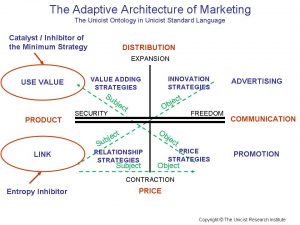The 10-Year Future Scenario of Object Driven Marketing
The future scenario for Object Driven Marketing was developed by the Future Research Lab of The Unicist Research Institute, led by Peter Belohlavek, to provide information on the next step in marketing in the XXI Century. The following synthesis of the results of the research shows what is already happening in the market and how these actions will evolve due to the use of the technologies that are now available. Object Driven Marketing implies transforming the activity of marketing managers from a technical analytical role to an architectural role.
To access the basics on Unicist Future Research please enter:
www.unicist.org/sdp.shtml
Introduction
Commercial objects are homologous to the autopilot of an airplane. They are automated adaptive units to influence the marketing having a scope within which they are functional. When the scope is exceeded it is necessary that the managers assume the responsibility to influence the market with other means.
Merchandising, packaging and promotion can be considered as some of the predecessors of commercial objects. Object driven marketing is just the materialization of traditional marketing mix in a structured adaptive commercial process.
But this process requires being able to emulate in mind the structure of the different segments that are addressed in a commercial process. This requires the use of models that make this possible in a reasonable, understandable and provable way.
Unfortunately, the proof can only be confirmed when the market has been approached. That is why object driven marketing requires a full credibility in what is being done.
Object driven marketing integrates commercial driving objects to influence buying decisions, entropy inhibitors to avoid losing clients, catalysts to influence the commercial process and gravitational object to sustain the value propositions. Inhibiting objects are used to avoid dysfunctional commercial activities.
The drivers towards object driven marketing are:
- The customer relationship management systems
- Supply driven or highly competitive markets
- Global marketing
- The market orientation of companies
The new technologies that make object driven marketing possible are:
- Adaptive IT solutions
- Internet
- Consumer behavior segmentation
- Corporate behavior segmentation
- Commercial Objects
- Semantic and Semiotic objects
- Unicist Ontology of Ambiguous Language
- Adaptive automation
What will have happened during the next 10 years?
- The effectiveness of marketing campaigns will have been notoriously increased
- Global marketing will have become fully objects driven
- CRM will have become adaptive
- Diving objects will be regularly used
- Catalysts will be used by the market segments leaders
- The relative commercial cost will have been significantly reduced
- The role of marketing managers will be focused on marketing architecture
- The expansion of markets beyond the boundaries of an existing business will have been simplified.
“Adaptiveness is the name of the new Era”
The Role of the Architect
Architects can only design and monitor the construction of something that is being built if they have the functional model in their minds. Architecture begins being a mind model and ends integrated in a deed.
The role of the architect includes necessarily the integration of both the science and the technology that architects need to manage.
Art is what makes the integration of science and technology possible. In this sense, architects need to integrate both science and technology considering that the scientific knowledge they manage is essentially objective and the technologies are driven by the values of those who developed them.
Architecture requires a high level of knowledge in order to integrate the objective value, the subjective value and the environment in a unified field. It has to be considered that the etymology of architects implies “director of works”.
Architects need to build a functional model that represents the object that will be constructed.
This functional model requires having apprehended the ontological functionality of reality, having developed a strategy that includes both maximal strategies, to expand the functionality of the object that has been built based on the knowledge of its unified field, and minimum strategies, to ensure the functionality of the model.
Access the complete synthesis at:
http://unicist.net/marketing/the-10-year-future-scenario-of-object-driven-marketing
Unicist Press Committee
NOTE: The Unicist Research Institute was the pioneer in complexity science research and became a private global decentralized leading research organization in the field of human adaptive systems.
http://www.unicist.org
